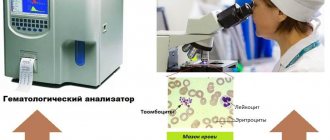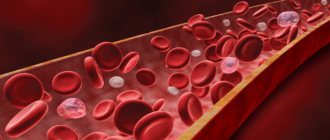Screening of the hemostasis system (that is, the blood coagulation system) is perhaps one of the most frequently prescribed tests in modern laboratory diagnostics. And this is easy to explain. Determination of hemostasis indicators is the most important stage of examination in identifying various disorders of the cardiovascular, gynecological, hepatological, phlebological, endocrine profile, etc. This study is indispensable when monitoring the condition of patients in the pre- and postoperative period.
This analysis is necessarily carried out if a person is identified as having a tendency to form blood clots or, conversely, if there is excessive bleeding (hyper- and hypocoagulation, respectively). The first variant of deviation from the norm is often found in elderly and heavy smokers, and in women who take oral contraceptives for a long time. Also, increased blood clotting can accompany infectious diseases, injuries, and burns. Frequent nosebleeds and a tendency to form bruises literally “out of the blue” can indicate the body’s predisposition to excessive bleeding.
The hemostasis system performs several vital functions. Firstly, it is maintaining a liquid state of blood in the vessels. Secondly, it stops bleeding (due to thickening and the formation of a clot-embolus) in case of vascular injury. In addition to the “options” of coagulation and anticoagulation, there is a third function - dissolving (fibrinolysis). It is she who is responsible for the resorption of the blood clot after the integrity of the vessel is restored. Of course, any failure in these delicate processes can lead to consequences dangerous to health and even life. Hemostasis screening allows you to assess how well the coagulation system copes with all its functions.
General information
Every qualified doctor knows that it is best to begin the treatment of any patient by collecting an anamnesis, which is nothing more than a collection of information about the state of a person’s health.
As a rule, any medical examination begins with asking the patient himself about previous diseases or surgical interventions, allergic reactions or hereditary predisposition to certain ailments, and so on.
Then the doctor prescribes a series of laboratory tests or simply tests that will help supplement the anamnesis with information about the development of the disease, as well as information necessary for choosing a treatment method or further diagnosis.
Coagulological studies (abbreviated as coagulogram ) occupy an important place among laboratory blood tests that are necessarily carried out in preparation for surgery, for example, during a planned cesarean section or during pregnancy .
Coagulogram - what is it?
Many patients needlessly begin to worry when they hear from their attending physician such unusual at first glance words as coagulogram or otherwise hemostasiogram . So what kind of coagulogram analysis is this and why is it taken?
First of all, it is worth noting that this is a fairly common method in modern medicine for studying the functioning of the hemostatic system of the human body, which is responsible for such important vital functions as stopping bleeding when blood clots or blood vessels , as well as maintaining the normal fluid state of the blood.
Hence the answer to the question of what a hemostasiogram - a study that determines how well the body’s hemostasis system functions. A blood coagulogram test helps to study such an important blood function as the ability to clot, i.e. formation of a blood clot.
Having received the results of coagulation , the attending physician can predict in advance the outcome of the operation or childbirth. Information about blood clotting is vital in emergency situations, for example, when a person is injured, when seconds count and you need to stop the bleeding .
Therefore, you hardly need to worry too much about how much this research costs. After all, the price of a hemostasiogram cannot be compared with the confidence that the patient will be alive and healthy.
Indications for prescribing such an analysis as a hemostasiogram are the presence of the following diseases in the patient:
- intestinal thrombosis;
- stroke;
- thromboembolism
- vascular thrombosis and varicose veins of the lower extremities;
- chronic cirrhosis
- gestosis;
- inflammatory processes in the acute stage;
- hemorrhagic pathologies, for example thrombocytopenia , hemophilia or von Willebrand disease .
In addition, such an analysis is necessarily prescribed to determine the rate of blood clotting in preparation for planned operations, for example, cesarean section, as well as during pregnancy to assess the state of hemostasis and before spontaneous childbirth . Every woman in labor must have a blood test such as a coagulogram in her exchange card.
Human hemostasis system
Having determined what a hemostasis test is, it is worth understanding in more detail such a concept as blood clotting . Perhaps we should start with a definition. So, the hemostasis system of the human body is the most important biological system, the main functions of which can be considered to be the preservation of basic blood parameters, as well as stopping bleeding.
It is not for nothing that the human body is called the whole universe and is compared to a complex mechanism. And the hemostasis system can serve as a striking example of how ingeniously people are designed. Blood is a unique biological fluid that can literally work miracles in our body.
It not only circulates through the vessels, but also, unnoticed by a person, restores veins and arteries throughout his life due to its ability to form blood clots or dense clots, i.e. roll.
There are three main components of the human hemostasis system:
- endothelial cells (the inner layer consisting of flat cells lining lymphatic and blood vessels, as well as the cavities of the heart), which, when vascular walls rupture or other damage, are capable of releasing biologically active components such as prostacyclin , thrombomodulin and nitric oxide . They, in turn, trigger the process of blood clot formation.
- Platelets or blood platelets that have the ability to “stick together” with each other in order to subsequently form a primary hemostatic plug .
- Plasma factors (15 plasma factors in total, most are enzymes ) that, due to chemical reactions, form a fibrin clot , which should finally stop the bleeding.
Summarizing all of the above, we can clearly answer the question of what a blood test for hemostasis shows during pregnancy, in preparation for a planned operation, or during diagnostics. This test gives an idea of how well or poorly a patient's blood is clotting. In other words, how quickly doctors can stop bleeding when it occurs.
Indications
A hemostasiogram is prescribed to expectant mothers 2-3 times before birth without fail. Indications for additional blood testing for coagulation are:
- increased uterine tone;
- varicose veins of the lower extremities, anus, esophageal veins;
- a history of miscarriages or miscarriages of pregnancies at different stages;
- diseases of the liver and kidneys that lead to disruption of their function;
- the presence of bad habits in a woman, which increases the risk of developing complications in the blood clotting function;
- presence of blood diseases in the family - hemophilia, thrombosis, varicose veins;
- frequent nosebleeds;
- autoimmune diseases;
- cardiovascular diseases;
- multiple pregnancy;
- fetoplacental insufficiency, late gestosis, intrauterine growth retardation;
- pregnancy resulting from IVF.
Interpretation of blood coagulogram
The blood test for a coagulogram includes many different indicators that you need to be able to read correctly, i.e. understand and analyze, in other words, decipher. Unfortunately, not every doctor has the skills to decipher hemostasiogram indicators. And only a highly qualified specialist can correctly interpret certain parameters of this analysis.
After conducting laboratory tests of the patient’s blood and receiving the results, the attending physician compares the decoding of the coagulogram with the norm established for adult patients, as well as children. It is important to remember that the normal coagulogram for a child, man or pregnant woman is very different. This is due, first of all, to the peculiarities of the functioning of the body of people of different sexes in different age categories.
Coagulogram indicators
Let's consider the parameters of the blood clotting test, namely the normal hemostasiogram values. Then we will dwell on each of them in more detail, and also talk about an extended or expanded coagulogram.
It is worth noting that the table below shows several options for normal indicators of such hemostasiogram parameters as bleeding time and blood clotting time . This is due to different interpretations of the norm for these parameters by specialists involved in their study.
| Indicator name (abbreviated name) | Standard value of the indicator |
Blood clotting time:
|
|
Bleeding time:
|
|
| International Normalized Ratio (INR or INR) | 0,82-1,18 |
| Thrombin time (TV) | 14-21 seconds |
| Prothrombin index (PTI) | 73-122 % |
| Activated Recalcification Time (ATR) | 81-127 seconds |
| D-dimer | 250.10-500.55 ng/ml* |
| Prothrombin time (PT) according to Quincke | 11-15 seconds |
| Antithrombin III (AT III) | 75,8-125,6 % |
| Activated Partial Thromboplastin Time (APTT) | 22.5-35.5 seconds |
| Fibrinogen | 2.7-4.013 grams |
| Soluble fibrin-monomer complexes (SFMC) | 0.355-0.479 units* |
*International Unit (IU) or Action Unit (AU) , i.e. a measure of measuring the dose of a substance based on its biological activity.
*Nanograms per milliliter. Source: Wikipedia
Clotting time
This laboratory test of the patient's blood gives the doctor an idea of the time it takes for the body to form a blood clot. There is no shorthand symbol for this parameter in the analysis. During the research, biological material (blood) taken from a patient’s vein is placed in a sterile and dry tube, and then the time is noted and they wait until a visible blood clot forms.
When the blood clotting time is normal, the doctor can conclude that the hemostasis system is working correctly, and also exclude some pathological conditions, for example, hemophilia or disseminated intravascular coagulation syndrome , in which a blood clot does not form at all. If the blood clotting time deviates from the norm (increase or decrease in indicators), you should understand the reasons in more detail.
For example, prolongation of bleeding time can be observed in hemophilia , systemic lupus erythematosus or rheumatoid arthritis , as well as in peritonitis , chronic liver pathologies , pneumonia and the presence of a malignant tumor. A shortened bleeding time may be a signal of the development of anaphylactic or hemorrhagic shock , as well as myxedema .
In addition, all coagulogram indicators, including this one, may deviate from the norm during pregnancy. Women, as a rule, first learn about the name of a blood clotting test during pregnancy, when they are required to undergo many laboratory tests in order to monitor and promptly influence the health of the mother and unborn child.
The changes that rapidly occur in the body of a pregnant woman do not leave their mark on the properties and characteristics of the blood. It is noteworthy that there is a gradual decrease in blood clotting time starting from the first trimester, and in the third trimester this indicator can differ greatly from the norm. However, do not be afraid, since this is just one of the protective mechanisms that help prepare the female body for childbirth and reduce possible blood loss.
Bleeding time
In accordance with the standards, the duration of bleeding should not be less than or more than a few minutes from the moment of puncture, the so-called primary hemostasis. To complete the process, i.e. The formation of a blood clot should take an average of 10 minutes maximum. Blood clotting time is a very important indicator that plays a big role in preparing the patient for surgery, for example, during a cesarean section.
The norm of blood clotting in women does not differ from the standards established for adults. The rate of blood clotting in children depends on the age of the child. On average, the duration of bleeding should not exceed 2-4 minutes, and a blood clot should form within 2-5 minutes.
Bleeding time may be increased if:
- hemophilia;
- thrombocytopenia , i.e. with a lack of platelets in the blood;
- hemorrhagic fever , for example, with Ebola or Crimean-Congo ;
- liver damage from alcohol (intoxication) ;
- thrombocytopathy;
- drug overdose.
How to take a blood clotting test?
In order for the doctor to receive undistorted information after laboratory tests, one should take the correct approach to taking any tests, including blood clotting tests. Biological material is taken in the morning, always on an empty stomach. It should be remembered that at least 8, and preferably 12, hours must have passed since the last meal.
In addition, you should refrain from taking alcoholic beverages and medications on the eve of the study, as this may affect the test result. If the patient is forced to take any medications, he must remember to inform the medical professional about this.
Prothrombin time
What is prothrombin time? This is one of the main laboratory indicators of a coagulogram used by doctors to assess the hemostatic system of the human body as a whole, as well as to determine the effectiveness of drugs that prevent blood clotting.
PT reflects phases 1 and 2 of plasma coagulation. In other words, the time of formation of a thrombin clot in the blood when thromboplastin and calcium are added. For this parameter, the abbreviated designation PV is accepted; sometimes PVT is also used. Blood coagulation test parameters such as international normalized ratio (INR) and prothrombin index (PTI) are derived from prothrombin time, the norm of which varies depending on the age and gender of the patient.
For example, the normal thrombin time in women and men is 11-15 seconds. Standards are established for children depending on their age. For example, for newborns - 13-17 seconds or 14-19 seconds for premature babies. For an older child (from 10 years old) the norm is 12-16 seconds, and for a younger child – 13-16 seconds.
Thrombin time is higher than normal - what does this mean? Deviation from the standard indicators established for a given coagulogram parameter may mean the following:
- lack of vitamin K in the body;
- low concentration or deficiency of blood clotting factors 1,2,5,7, and 10;
- disruption of the normal functioning of the liver, liver failure or other diseases of this organ;
- presence of DIC syndrome .
Prothrombin time is increased, what does this mean? As a rule, exceeding the PT indicator is associated with the patient taking medications belonging to the group of anticoagulants, i.e. drugs that have anti-clotting properties, such as Heparin, Coumadiline or Warfarin.
International Normalized Ratio
Prothrombin ratio (abbreviated PTI) or INR in a blood test, what is it? Let's start with a little background. Such a parameter as INR in a hemostasiogram appeared in 1983, when the World Health Organization (hereinafter referred to as WHO) decided to streamline the work of research laboratories and bring all indicators of blood clotting tests to a single standard understandable to doctors all over the world.
Previously, each laboratory could use different thromboplastin reagents , which could distort the final research results. This coagulogram parameter is abbreviated as INR or INR. In domestic medicine, you can currently still find instead of INR such an indicator as the prothrombin index, which reflects how well the patient’s blood clots.
However, due to different methods for determining this parameter, it is considered unstable and therefore it is customary to use INR abroad. In a blood test for PTI and INR, the norm is set at the level:
- PTI - 70-100, and for patients taking Warfarin - 24.0-42.6;
- INR – 0.82-1.18.
So what is INR in a blood test? This is an indicator that is nothing more than the ratio of the PT of the patient’s analysis and the PT of the control sample. The INR norm in a human blood test according to international standards can range from 0.82 to 1.18.
If there is a deviation from the above values, the patient may be diagnosed with the following diseases:
- with elevated PT and INR levels: chronic hepatitis , vitamin K , liver cirrhosis , amyloidosis , DIC syndrome , decreased fibrinogen levels, nephrotic syndrome, intestinal dysbiosis, deficiency of coagulation factors (2.5, 7 and 10);
- with reduced PT and INR values: vascular thromboembolism , increased activity of factor 7, thrombosis or activation of fibrinolysis .
In addition, an increase in INR and PT may indicate the presence of anticoagulant drugs in the patient’s blood. Therefore, the INR norm when taking Warfarin differs from the established standards. For patients taking this drug and drugs similar to it in action, the following range of normal INR values is used - 2.0-3.0.
The INR norm in the blood of women usually does not differ from the general values. But during pregnancy, the female body changes so much that the INR norm during pregnancy may not coincide with the above numbers.
Activated partial thrombin time
APTT blood test - what is it? This is another analysis indicator that provides information about the effectiveness of plasma factors designed to quickly stop bleeding. This parameter is abbreviated as APTT.
APTT blood test - what is it? The parameter is often called activated partial thromboplastin time. APTT, like APTT, provides information about the rate of formation of a fibrin clot and best characterizes the internal process of hemostasis. It is believed that the APTT indicator is the most accurate, but at the same time the most sensitive, because may vary depending on the reagents used in laboratory tests.
The general norm of aPTT in human blood is set at 22.5-35.5 seconds. The APTT rate in women also corresponds to the above values. However, as is the case with other coagulogram parameters, the APTT rate during pregnancy does not always correspond to the general rules. Let us consider the reasons for the deviation of this indicator from the norm.
As a general rule, if the APTT is elevated, this means that the hemostatic system is unstable or the patient is taking Heparin and its analogues, for example Fraxiparine , Clexane , and Cibor .
When the above reasons are excluded, and the aPTT is higher than normal, this means that the patient may have diseases such as:
- fibrinolysis;
- acquired or possibly congenital deficiency of coagulation factors (8, 9, 11, 10, 12, 2 and 5);
- DIC syndrome (stage 2 or 3);
- autoimmune pathologies (usually systemic lupus erythematosus );
- liver diseases.
When APTT is low, what does it mean? If the value is below normal, this indicates that the blood's ability to clot is reduced. The main reasons for this condition may be:
- DIC syndrome 1st degree;
- increased coagulability;
- an error during laboratory tests, for example, incorrect blood sampling.
Soluble fibrin-monomer complexes
Abbreviated in a coagulogram as RFMK. RFMK analysis, what is it? It’s worth starting with the definition of fibrin-monomer complexes - these are products of the breakdown of a blood clot during the process of fibrinolysis . According to researchers, this indicator is quite difficult to reliably determine, since soluble fibrin-monomer complexes are very quickly removed from the blood.
Such a parameter as RFMC plays a big role in the diagnosis of DIC syndrome (full name - disseminated intravascular coagulation syndrome) . The norm of RFMK in human blood is 0.355-0.479 units. However, during pregnancy, RFMC norms may differ significantly from the above indicated level. Since the female body is actively preparing for the upcoming birth, the basic parameters of the blood change along with it, including its ability to clot.
This is a kind of defense mechanism that helps minimize the risk of bleeding. Deviations of RFMC levels during pregnancy of up to 5.1 ml are considered normal. per 100 ml. blood. If RFMK is elevated, what do these analysis results mean?
When RFMK is increased in a patient’s coagulogram, the reasons may be as follows:
- shock;
- thromboembolism of the deep veins of the extremities or pulmonary artery;
- sepsis;
- gestosis or preeclampsia during pregnancy;
- connective tissue pathologies;
- renal failure in the chronic or acute stage.
An increase in this indicator is often found in patients who have recently undergone surgery. Therefore, in the postoperative period, the analysis for RFMC may deviate from the norm.
Activated recalcification time
Abbreviated as ABP in the analysis, it denotes the time required for the formation of fibrin in blood plasma saturated with platelets and calcium. This parameter is also used to evaluate the blood coagulation system as a whole. AVR reflects the interaction of cellular and plasma components of hemostasis.
It is noteworthy that the value of this parameter may vary depending on the reagents used in laboratory tests. As a rule, a shortened recalcification time indicates the patient’s body’s tendency to form blood clots, and an extended one indicates hemophilia, as well as a decrease in the number of platelets and a change in their basic characteristics.
Prothrombin index. Norm for women
The abbreviated name for this parameter in the analysis is PTI. Blood test for PTI - what is it? The prothrombin index is the ratio of the established ideal value of prothrombin time to the prothrombin time in the patient’s analysis, multiplied by 100%.
It is noteworthy that this indicator is currently almost never used, since WHO recommends the use of such a parameter, which is more resistant to laboratory tests, such as INR. The normal level of PTI in the blood for a healthy person is set at 73-122%.
As a general rule, the rate of IPT in women should not differ from the above values, with the exception of the period of pregnancy, when blood clotting increases. Therefore, if a woman’s coagulogram deviates from the norm, she should consult a doctor for advice. This parameter increases, as a rule, if the human body lacks vitamin K, and there is also a deficiency of blood clotting factors.
In addition, an increase in PTI is caused by treatment with anticoagulants such as Sincumar , Warfarin or Neodicoumarin , as well as when taking Heparin and its analogues. PTI decreases with liver damage, for example, with cirrhosis and hepatitis, with vascular thrombosis and during pregnancy.
Norm of prothrombin for women in the blood
In the hemostasis system, 15 coagulation factors play a fundamental role, i.e. substances that characterize the correctness of its operation. One of the most important factors is prothrombin or factor II, also known as thrombogen . This is a protein that is a precursor to thrombin, which in turn is responsible for the coagulation function of the blood - it stimulates the formation of a thrombus (blood clot).
The level of prothrombin in the blood is determined using the following tests:
- PV according to Quick – the norm for women is 78-142%;
- INR or INR - the norm for women is 0.85-1.15.
If the level of factor II is higher than normal, then blood circulation is hampered due to the fact that the blood becomes viscous, as a result, the blood vessels become clogged. With this condition, the patient's body is more at risk than ever of strokes and heart attacks , and the risk of developing malignant tumors or thromboembolism .
When thrombogen are low, blood clot formation occurs abnormally slowly, which can lead to significant blood loss if bleeding occurs. As a rule, the causes of such a failure in the hemostatic system are: lack of vitamin K in the body or other congenital and acquired factors.
Thrombin time
Abbreviated name – TV. This parameter characterizes the final stage of hemostasis and determines the length of time required for the formation of a fibrin when thrombin . Monitoring of TV is always carried out in combination with PT and APTT for the most effective diagnosis of congenital fibrinogen pathologies, as well as to assess the effectiveness of fibrinolytic and heparin therapy.
Fibrinogen
What is a fibrinogen blood test? The first coagulation factor or fibrinogen is nothing more than a protein formed under the influence of the Hageman factor in the liver, and subsequently, under its influence, converted into insoluble fibrin . The presence of fibrinogen is determined by performing a thrombotest.
Thrombotest grades 4 and 5 are considered normal. It is worth noting that since fibrinogen (an acute phase protein), its level increases in the blood during stress, injury or infection. As a general rule, the level of fibrinogen in the blood should be between 2.7 and 4.013 grams. The level of fibrinogen in women's blood should not be lower or higher than the specified values, except during pregnancy.
A pregnant woman's blood parameters undergo changes, as does her entire body. Many protective systems are launched, including the hemostasis system in preparation for the upcoming delivery. Often, already in the first trimester, fibrinogen levels may be slightly higher or lower than normal. For this period of pregnancy, indicators are set from 2.3 to 5 g/l.
When the level of this protein increases, the blood becomes denser and thicker. Because of this, the process of thrombus formation begins, which harms the child, because he will suffer from an acute lack of oxygen and, as a consequence, from a deficiency of important micro- and macroelements, as well as vitamins. During pregnancy in the second trimester, the fibrinogen level should be within the normal range of 2.4-5.1 g/l, and in the third trimester - up to 6.2 g/l.
Elevated levels of fibrinogen are also observed with:
- myocardial infarction;
- burn disease;
- menses;
- rheumatoid arthritis;
- amyloidosis;
- pneumonia;
- pyelonephritis;
- systemic scleroderma;
- peritonitis.
In addition, medications such as Heparin and oral contraceptives affect protein levels.
A low level of fibrinogen indicates that the patient has diseases such as:
- DIC syndrome;
- prostate cancer;
- liver cirrhosis and other organ pathologies;
- leukemia.
Fibrinogen levels may decrease with Heparin , as well as when the patient takes anabolic steroids, valeric acid, androgens, fish oil and barbiturates .
Antithrombin III
This physiological anticoagulant is classified as a glycoprotein , i.e. substances capable of inhibiting coagulation factors 9, 10 and 12 and thrombin. It is synthesized in liver cells. Standard indicators for this coagulogram parameter vary depending on the patient’s age.
For adults, the normal rate will be 75-125%, for newborn children - 40-80%, for children from 10 to 16 years old - 80-120%, and under 10 years old - 60-100%. If antithrombin 3 is low, what does this mean? A decrease in the level of this anticoagulant may be associated with the presence of diseases in the patient such as disseminated intravascular coagulation syndrome, sepsis, ischemia, liver cirrhosis, thromboembolism or thrombosis .
In addition, antithrombin III may decrease in the last trimester of pregnancy and when the patient takes Heparin or fibrin inhibitors. When antithrombin 3 is elevated, the causes may be inflammatory pathologies, for example, peritonitis, pyelonephritis and pneumonia , as well as hepatitis and vitamin K .
D-dimer
Another indicator of an extended coagulogram, with the help of which the doctor analyzes not only blood clotting, but also the anticoagulant system of the human body. D-dimer is split fibrin strands. Only an increased result of this parameter is significant, which indicates the development of liver diseases, disseminated intravascular coagulation syndrome, thrombosis, ischemia, arthritis, and myocardial infarction in the patient’s body.
In addition, an increase in D-dimer is a sign of heavy smokers.
Laboratory tests used
RFMK
The test allows you to quantify the level of soluble fibrin in plasma, or, in other words, the level of thrombinemia. An increase in the number of RFMK is observed during thrombosis, thrombophilia, and in late pregnancy in accordance with the increase in fibrinogen content. The test can also be used to assess the effectiveness and sufficiency of anticoagulant therapy based on its final result - the elimination of thrombinemia (the obtained values are within the reference values).
Ethanol test
With an increase in the level of thrombinemia and the presence in the test plasma of complexes of fibrin monomers with fibrinolysis products and fibrinogen, a jelly-like clot is formed under the influence of ethanol (positive result, 1). Correlates with RFMK. In a healthy person, a clot does not form (test negative, 0).
D-dimers
Elevated D-dimer levels are found in numerous conditions associated with activation of coagulation (disseminated intravascular coagulation syndrome, deep vein thrombosis, pulmonary embolism, massive tissue damage or surgery, heart failure, infections, inflammation, neoplastic conditions).
Despite the limited specificity of the test (about 50%), the determination of D-dimer has advantages over the measurement of other markers of coagulation and fibrinolysis, since D-dimer is formed only from the final product of the conversion of fibrinogen to fibrin - insoluble fibrin, that is, it is a product thrombus lysis. With primary fibrinolysis and dysfibrinogenemia, the level of D-dimer does not change.
The concentration of D-dimer in the blood is influenced by such factors as the size of the thrombus, the time from the onset of clinical manifestations to the prescription of anticoagulant therapy, etc. While taking anticoagulants, the level of D-dimer gradually decreases, and thrombolytic therapy causes an increase in the level of D-dimer.
The test is most characterized by a negative diagnostic value (about 100%), i.e. a negative result with a high degree of probability allows us to exclude the diagnosis of thrombosis.
In pregnant women, starting from early pregnancy, the level of D-dimer in the blood gradually increases. By the end of pregnancy, its values can be 3-4 times higher than the initial level. Significantly higher levels of D-dimer are observed in women with complicated pregnancy (preeclampsia, preeclampsia), as well as in pregnant women with diabetes and kidney disease.
An increase in D-dimer levels has been found in people over 80 years of age.
Indications for the purpose of analysis.
- Diagnosis of thrombotic conditions. Deep vein thrombosis (exclusion test). Pulmonary artery thromboembolism (PE).
- Disseminated intravascular coagulation syndrome (DIC).
- Complicated pregnancy.
- Monitoring thrombolytic therapy.
Level up.
- Arterial and venous blood clots (including deep vein thrombosis, pulmonary embolism).
- DIC syndrome.
- Infections, sepsis.
- Inflammation (slight increase).
- Liver diseases.
- Extensive hematomas.
- Presence of rheumatoid factor.
- Pregnancy.
- Surgical interventions.
- Age over 80 years.
- Oncological diseases.
- Thrombolytic therapy.
Coagulogram during pregnancy
What is a coagulogram during pregnancy? This is the same coagulogram that is necessarily prescribed to women during pregnancy, as well as immediately before preparing for childbirth.
During pregnancy, the norm for all blood clotting test indicators does not correspond to generally accepted values for the body of a healthy adult.
This is due, first of all, to the fact that the hemostasis system of a pregnant woman undergoes serious changes, as does her entire body as a whole due to the emergence of another blood circulation - the uteroplacental. progesterone predominates, also play an important role .
It is noteworthy that during pregnancy the activity of blood clotting factors such as 7,8 and 10, as well as fibrinogen, increases significantly. This is a kind of natural protective mechanism designed to help increase the chances of a favorable birth outcome.
Fibrin fragments are deposited on the walls of blood vessels and thus the fibrinolysis system is suppressed. This allows the female body to be safe in case of placental abruption or miscarriage, uterine bleeding and the formation of intravascular blood clots.
Decoding coagulogram indicators during pregnancy
| Abbreviated name of the indicator, unit of measurement | I trimester of pregnancy | II trimester of pregnancy | III trimester of pregnancy |
| RFMK, ED | 78-130 | 85-135 | 90-140 |
| Platelets, *109/l | 301-317 | 273-298 | 242-263 |
| Antithrombin III, g/l | 0,222 | 0,176 | 0,155 |
| AVR, with | 60,1-72,6 | 56,7-67,8 | 48,2-55,3 |
| Prothrombin index, % | 85,4-90,1 | 91,2-100,4 | 105,8-110,6 |
| Fibrinogen, g/l | 2,91-3,11 | 3,03-3,46 | 4,42-5,12 |
| APTT, s | 35,7-41,2 | 33,6-37,4 | 36,9-39,6 |
Total average thrombogenicity index
The total average thrombogenicity index (AIT) is a calculated indicator that allows you to evaluate the direction of shift in the patient’s hemostatic system, the result of the interaction of all hemostatic systems: coagulation, anticoagulant, fibrinolytic, antifibrinolytic. If the reference limits are exceeded (SSIT > 1.1), the patient is prone to hypercoagulation; if it decreases (SSIT < 0.8), the patient is prone to hypocoagulation. Evaluating the results of specific tests allows us to determine by what mechanisms of hemostasis the balance is disturbed and what measures need to be taken to restore it.
How to take a coagulogram?
We talked about what a coagulogram is and why this test is taken. Now let’s figure out how to properly undergo a hemostasiogram so that, based on the results obtained, the doctor can make the right conclusion and choose an effective treatment plan.
So, if you need to do a blood clotting test, then remember the following rules:
- blood is donated exclusively on an empty stomach, it is better that more than 12 hours have passed since your last meal;
- on the eve of the analysis, you should not eat too spicy food, you should also refrain from smoked meats and overly fatty foods;
- It is strictly prohibited to drink any alcohol, even if the drink contains a small percentage of it;
- don't smoke;
- It is recommended not to take medications before the analysis, and if medications are vital, you should definitely notify the laboratory technician about this and indicate which medications are prescribed to you.
A standard hemostasiogram can be done in most public clinics, and an expanded or detailed analysis is more often available in paid medical institutions. For example, in the Invitro laboratory, a coagulogram can be done quite quickly. As a rule, the test result can be collected within a couple of days. This is due to the need for a number of chemical reactions that require a certain amount of time, which simply cannot be avoided.
However, in any case, you will receive the result of a paid analysis much faster than in a government institution, where the laboratory is heavily loaded due to the influx of patients or may not have certain reagents necessary for the study. The cost of the analysis depends on the number of parameters that need to be studied and varies from 1000 to 3000 rubles.
Blood collection
Eating food, including juice, tea, coffee, and alcohol, is not allowed for 8 hours (preferably 12) before the test. You can drink water. Blood is collected for a hemostasiogram in special tubes with a blue cap containing sodium citrate. Sodium citrate binds calcium ions and prevents blood clotting. Blood must be drawn exactly to the mark on the tube. If the blood-citrate ratio is abnormal, test interpretation is difficult. After collection, the blood is thoroughly and gently mixed with citrate without violent shaking. When taking a hemostasiogram against or after taking medications that affect blood clotting, they must be indicated on the referral form.








